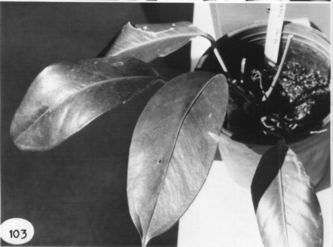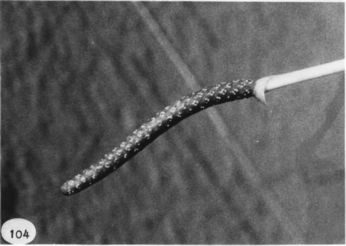





Anthurium lactifructum Croat, sp. nov.
TYPE:Panama. Darien: Serrania de Canasas, vicinity ofTorti, 38.6 mi. E ofBayano Dam Bridge, trail from village to mountains near Río Torti, ca. 250 m, António 4694 (MO 2802293, holotype; K., PMA, US, isotypes; Live at MO).
Planta epiphytica; cataphyllum persistens in fibris tenuibus; petiolus subteres, sulcatus, 7-18 cm longus; lamina coriacea, elliptica ad oblongo-elliptica, basi obtusa ad acuta, 19.5-23.2 cm longa, 6.5-9 cm lata; pagina inferiore, fusco-glanduloso-punctata; inflorescentia effusa; pedunculus 23-41 cm longus; spatha subcoriacea, pallide viridis sufflisa violacea, lanceolata, 2.8-4.5 cm longa, 0.7-1.7 cm lata; spadix olivaceus lavandulascens per anthesin; baccae albae, subglobosae, ca. 6 mm longae, 5-8.3 mm diam.
Epiphyte; stems less than 10 cm long, ca. 1 cm diam.; leaf scars 8 mm wide; roots moderately thin, green, relatively long; cataphylls 2-3 cm long, drying brown, weathering into fine, persistent fibers.
LEAVES spreading; petioles 7-18 cm long, 3.5-4 mm diam., subterete, bluntly and shallowly sulcate; geniculum 1.5-2.2 cm long; blades elliptic to oblong-elliptic, coriaceous, long-acuminate at apex, obtuse to acute at base, 19.5-23.2 cm long, 6.5-9 cm wide, broadest at middle; upper surface matte to semiglossy, eglandular, lower surface semiglossy, dark glandular-punctate; midrib convexly raised at base above, more acute midway, diminishing and sunken at apex, convexly raised below; primary lateral veins 8-12 per side, departing midrib at 40° angle, etched into surface above, flat to prominulous below, straight to collective vein; interprimary veins scarcely visible on both surfaces, drying more or less as prominent as primary lateral veins on lower surface; collective vein arising from the base, etched into surface, equally as prominent as primary lateral veins.
INFLORESCENCE spreading, longer than leaves; peduncle terete, 23-41 cm long, 3÷4 mm diam., 3-4 times longer than petioles; spathe subcoriaceous, pale green, tinged red-violet, lanceolate, 2.8-4.5 cm long, 0.7-1.7 cm wide, broadest near base, cuspidate at apex, acute and weakly decurrent at base, inserted at ca. 45° angle on peduncle; spadix olive green, becoming lavender at anthesis, tapered toward apex, 4.5-9.5 cm long, 4-5 mm diam. near base, 3-4 mm diam. near apex; flowers 4-lobed, ca. 3.5 mm long, ca. 2.8 mm wide, the sides sigmoid; 5-6 flowers visible in the principal spiral, 7-8 visible in the alternate spiral; tepals matte to semiglossy, weakly punctate, densely and minutely papillate, the lateral tepals 1-1.2 mm wide, the inner margins broadly rounded, tinged purplish; pistils emergent, dark green tinged purplish; stigmas elliptic, ca. 0.4 mm long, more or less obscure, not exserted; lateral stamens emerging throughout, quickly followed by alternates in no apparent pattern; anthers white, 0.3 mm long, 0.6 mm wide, held at side of pistil, retracting after anthesis; thecae oblong, not divaricate; pollen white, quickly dispersing.
INFRUCTESCENCE with white, subglobose, berries flattened at apex, sunken medially, ca. 6 mm long. 5-8.3 mm diam.; mesocarp thickly gelatinous; seeds usually 4, greenish white, bright green at apex, ca. 2.3 mm long, 1.4 mm wide, 1 mm thick, surrounded by a transparent sticky sac. Figs. 103 and 104.
Anthurium lactifructum is endemic to Panama in the Serrania de Canasas in southeastern Panama Province and eastern Darien Province at 15 to 85 m. The species is a member of section Porphyrochitonium and is characterized by its coriaceous, elliptic to oblanceolate-elliptic, glandular-punctate leaf blades that are two and a half to three times longer than the petioles, its green lanceolate spathe, tinged red-violet, its dark olive green spadix, and by its truncate, white berries (thus the name "lacti" "fructum"). In leaf shape and texture, the species is closest to Anthurium acutangulum and A. pirrense, which both have much longer peduncles and spadices and blades with the major veins beneath more prominently raised.
 |
 |
Darien: vicinity Río Torti, António 4694 (K, MO, PMA, US).